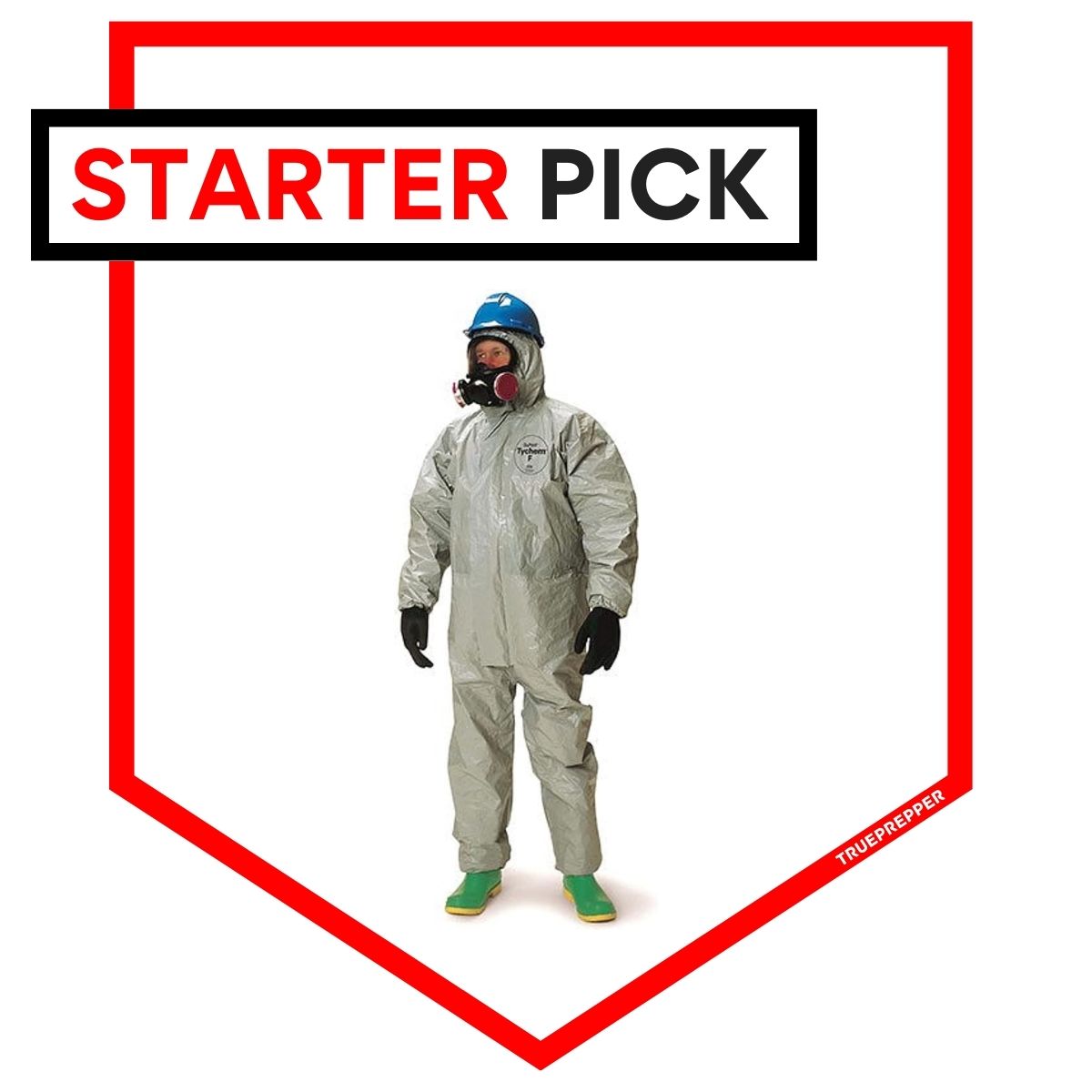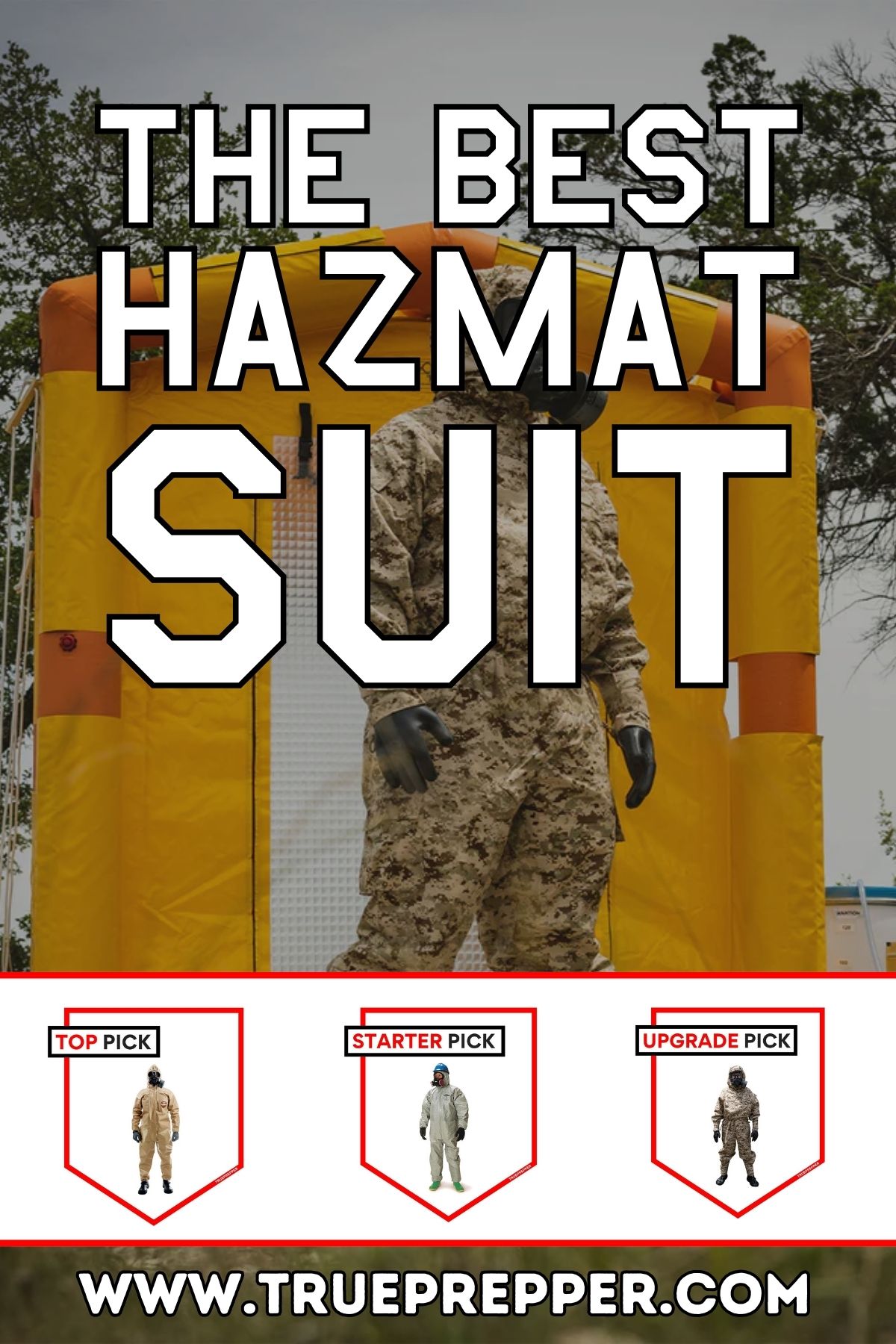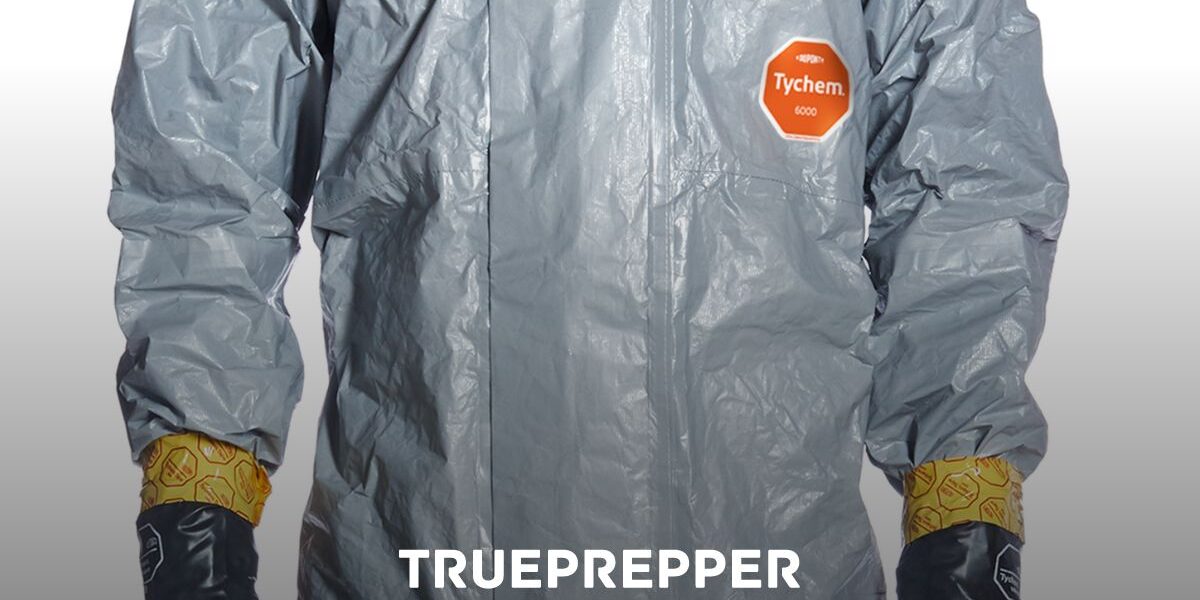Best Hazmat Suits for CBRN Protection
You don’t want to have to use it, but you’ll want one around when you need it. As a HAZMAT Technician, I can tell you that even the best hazmat suit is not fun to wear for long periods but hazmat suits have protected me from some nasty chemicals (including VX and mustard) over my career. I’m here today to share my insights because they work, and they’ll work for you too when you need one. There are several options to consider when it comes to hazmat suits: protection level, comfort, durability, etc.
This is where we come in. We’ve researched the best protective suits, tested each of them, and now the results are in: the overall best, a budget option, and an upgrade MOPP suit option. If you need a suit that will keep you covered, one of our recommendations will keep you protected.
Contents (Jump to a Section)
The Best Hazmat Suit
MIRA Haz-Suit
Tear-Resistant, Lightweight, and Effective
Military-grade HAZMAT protection available in a wide size range that you can store indefinitely.
*Price at time of publishing; check for price changes or sales.
A heavy-duty tear-and-puncture-resistant hazmat suit with an unlimited shelf life? Yeah, MIRA’s collaboration with Kappler is exactly what we needed. Bypass the lab-grade suits for a survival-grade hazmat suit meant to be worn while you are getting it done! You can easily outfit your family with these, knowing that they can tackle most threats for the better part of a day. Here is how it measures up:
- Puncture-resistant film composite
- Single-use after exposure, up to 8 hours rating on most threats
- Available in 6 sizes (including youth sizes), YS, YL, XS, S/M, L/XL, 2XL/3XL
- 1 pound
- Unlimited shelf life
- Made in the USA
With a durable construction and a price that doesn’t break the bank, it’s easy to see how the MIRA Safety HAZ-SUIT is the best choice out of all of the competition.
Budget Hazmat Suit
DuPont Tychem F 6000
Single-use, Lightweight, and Effective
Don’t break your budget but stay protected with a hazmat suit that will get you out of dodge.
*Price at time of publishing; check for price changes or sales.
Tychem 6000 is the minimum Tyvek suit spec rated for CBRN contamination, so it is the obvious budget choice. You won’t get by long in a contaminated area, but it offers more than enough protection to get away from the threat and decontaminate. I have plenty of experience with these in the field, and have my shelf stocked since they are cheap enough to buy in bulk.
Here are the specs:
- Barrier film laminated to DuPont Tyvek
- 30-minute protection against a wide range of chemicals (F 6000)
- Available in 7 sizes, SM, MD, LG, XL, 2X, 3X, 4X, 5X
- 1.25 pounds
- 5-year shelf life
- Made in the Czech Republic
Pick up a DuPont Tychem F Hazmat Suit to check off that NBC vulnerability on budget.
The Best CBRN MOPP Suit
MIRA MOPP-1 CBRN Suit
Operator-Grade, High-Quality, and Durable
Operate in CBRN environments with a carbon-activated MOPP suit that will protect you through multiple decontaminations.
*Price at time of publishing; check for price changes or sales.
Yeah, I get it. Close to $1,000 for a protective suit might seem a bit ridiculous, but the difference between this and our previous suggestions is that you will actually be able to operate an entire day in it. The carbon layer adds a ton of cost, but it is important in that it lets the suit breathe.
You won’t last more than 30 minutes inside most hazmat suits in a warm environment because air (and your body heat) will not be able to escape. This suit fixes that problem, letting you get work done in a contaminated environment. The breathability of the suit is mitigated by the carbon layer to neutralize chemicals. The price tag makes it not worth it or recommended for everyone- but if you want a top-line MOPP suit, this is the one to get. Here is how it measures up:
- Breathable, carbon-activated protection
- Washable decon up to 10 times
- Available in 3 sizes, S/M, L/XL, 2XL/3XL
- 4.5 pounds
- 10-year shelf life
- Made in the Czech Republic
If you are looking for the best of the best, pick up the MIRA Safety MOPP-1 Protective Suit to keep you covered.
Everything We Recommend

Military-grade HAZMAT protection available in a wide size range that you can store indefinitely.
Where to Buy
*at time of reviewing

Don’t break your budget but stay protected with a Hazmat suit that will get you out of dodge.
Where to Buy
*at time of reviewing
The Suits We Compared
Our research narrowed the field down to the several suits that we tested: DuPont, MIRA, Medtecs, 3M, AMZ Med Supply, and more.
You can see our full list of review criteria below in the What to Look For section, with an explanation for each.
We focused on Level B and below hazmat suits for practicality. Level A encapsulation paired with an SCBA system is overkill for many survival situations. Levels B/C/D, however, are much more achievable and can protect you from a wide variety of threats in a limited time frame.
We’re always looking for new and better equipment, so if you have a hazmat suit that you swear by let us know in the comments. We review most of our tested gear annually, so we can always get it in the next roundup round and see if it makes the cut and we can see if it will beat out our top picks.
What to Look For
The best hazmat suits have several important features to look for:
- Value
- Protection Level
- Comfort
- Size & Weight
- Durability
When you get the right blend of these, you can find a reliable protective suit that will encapsulate you in protection. Below, we break down what each of these features means for the hazmat suits and MOPP gear that set themselves apart.
Value: Cost vs. Benefit
The amount of money you spend on something like a hazmat suit shouldn’t blow out your entire budget. Don’t go overspending or overdo it. Budget according to your risk and your needs rather than just spending lavishly.
On the flip side, you don’t want to go too cheap or just plain get the wrong thing. A cheap bulk hazmat suit probably doesn’t have the rating to fight off chemical warfare agents and is more or less just coveralls for painting overspray.
You never want to spend too much money on one resource, especially something like a hazmat suit. It’s better to diversify your preparedness gear to make sure you are covered for a wide range of scenarios. There is a sweet spot where you get high value with not too high of a price, which is where our top pick sits.
Protection Level
For survival, we are expecting our hazmat suits to protect us from typical hazmat chemicals (except chlorine), chemical warfare agents, biological agents and toxins, and Alpha radiation particles (fallout).
These are all factors of what the suit is made out of, how the seams are taped (or not), and what tests the suit has passed. How well the suit itself protects you from specific threats shouldn’t be confused with HAZMAT levels or MOPP levels as those describe ensemble capability.
Comfort
We mentioned it earlier, but comfort is a huge factor for hazmat suits. When it is remotely warm outside a hazmat suit can turn into your personal sauna fast. Professional HAZMAT technicians use cooling vests to help combat this, but those are not very feasible unless you are using suits often.
I can tell you from experience that Level A in the Florida summer can be miserable even with cooling vests and a max zip time of 10 minutes.
Our upgrade pick offers permeability so it’s not quite as bad, but don’t kid yourself- nobody will be able to live inside a hazmat suit or MOPP for more than a few hours at a time unless it is cold or crisp outside.
Size & Weight
Size options are important because you want to get a hazmat suit that fits well. The baggier the fit, the more prone it will be to snagging and tearing. It’s also a good idea to make sure that your suit doesn’t ‘balloon up’. This is more of an issue with Level A HAZMAT configurations, but if your respirator or PAPR exhaust is going into your suit, you’ll fill up quickly even in a Level B setup.
The MOPP weighs considerably more than the Tyvec solutions because of the activated carbon. Five pounds can feel considerably more than one pound over time, so weight can be a drawback to consider.
Durability
Cheap hazmat suits are lightweight and thin, making them easy to puncture or tear. You certainly don’t want to deal with that in a life-or-death situation. If you do put your protective gear to the test and compromise a suit, you can attempt to repair it with good old ChemTape. I wouldn’t take the chance though- get the durable option up front.
Types of Hazmat Suits and MOPP Protection
Hazmat suits are made of a wide range of materials, coatings, and thicknesses and are designed for the different levels of hazmat operation:
- Level A – provides the highest level of protection and is used in situations where the highest level of respiratory, skin, eye, and mucous membrane protection is necessary. This is usually a fully encapsulated suit with SCBA.
- Level B – provides a lower level of protection and is used in situations where skin and eye protection are necessary but a lesser level of respiratory protection is acceptable. This is usually a taped suit with SCBA.
- Level C – provides the minimum level of protection and is used in situations where it is not necessary to protect against splashes, but only against inhalation of hazardous vapors. This is usually an untaped suit with SCBA, PAPR, or respirator.
- Level D – provides the lowest level of protection and is used for routine handling of hazardous materials where exposure is unlikely. This is usually eye protection and an optional respirator.
MOPP, or Mission-Oriented Protective Posture is commonly used in the military and has several levels:
- Mask Only – Wearing a respirator alone, usually used in emergency management exercises where heat is a factor.
- MOPP Ready – Have an entire MOPP gear ensemble ready in two hours and the mask carried with you.
- MOPP 0 – Have an entire MOPP gear ensemble within arms reach. This is very common.
- MOPP 1 – Wear the MOPP Suit, and have the rest of the ensemble within arms reach.
- MOPP 2 – Wear the MOPP Suit and the butyl rubber boots, and have the rest of the ensemble within arm’s reach. This is the most common MOPP posture.
- MOPP 3 – Wear the MOPP suit, the butyl rubber boots, and the protective mask. Have the gloves with you.
- MOPP 4 – Wear the entire MOPP ensemble. Common and best protection level.
Coordinated efforts are made in the military to have the minimum protective posture where the mission can still be carried out. Gloves and masks can slow down operations considerably and fatigue the wearers quickly.
Who Needs a Hazmat Suit?
Hazmat suits are not necessary for most people and only make sense for those who need to prepare for CBRN (or NBC) situations. You can check out our Prepper Risk Assessment to see if you should prioritize being prepared for Chemical, Biological, Radiological, and Nuclear attacks/accidents or if there are more pressing issues in your preparedness level to attend to.
Hazmat suits are considered essential for your:
- CBRN Kit
Full coverage suits also come in handy for your:
You can find other uses for the cheaper hazmat suits as well. At our budget pick’s price, you can use them around the house for full coverage protection in our crawlspace, or other household chores.
How We Review Products: We research thoroughly before selecting the best products to review. We have vast prepping and survival experience and bring in outside experts when needed. Hours on end are spent testing gear in stressful conditions and using specialized testing gear to verify claims. We assign performance criteria and impartially rate each tested item. Learn more about how we test.
Sources and References
All of our experience and the testing we do to determine the best hazmat suit is useless without listing our research sources and references. We leaned on these for the book knowledge that we paired with our hands-on testing and practical military and prepping experience:
Schreuder-Gibson, H., et al. (2003). Chemical and Biological Protection and Detection in Fabrics for Protective Clothing. MRS Bulletin. Volume 28. Pages 574-578. (Source)
Ondrey, G., et al. (2010). This hazmat suit is comfortable to wear. Chemical Engineering. Volume 117. Issue 13. Page 48. (Source)
Williamson, R., et al. (1999). A Thermal Physiological Comparison of Two HAZMAT Protective Ensembles With and Without Active Connective Cooling. Journal of Occupational and Environmental Medicine. Volume 41. Issue 6. Pages 453-463. (Source)
The Final Word
Hazmat suits and other CBRN protective gear are niche items that you will find useful only in a handful of scenarios. But they are also irreplaceable in those scenarios, making them an important part of prepping. If your threat profile includes nuclear, biological, radiological, or chemical vulnerabilities, CBRN gear is more than worth the investment.
Here are a few related articles our readers have also found helpful:
- The Best Geiger Counter for Radiation Detection
- The Best Gas Mask for Tear Gas, Viruses, and Nuclear Fallout
- Home Survival Kit List | 53 Essentials
We presented quite a lot of information, but as always: if you have any questions let us know and we would be happy to help. Our research and testing found the MIRA Haz-Suit to be the best option given its value, protection level, comfort, profile, and durability.
If you pick up one of our suggested hazmat suits- make sure you are familiar with it and know how to use it. If you don’t know how to put it on quickly, seal it off properly, or decontaminate it- you may as well not have one at all.
Keep exploring, stay prepared, and be safe.
You’ve Been Missing Out
Join the 2+ million preppers that rely on our prepping advice by subscribing to TruePrepper.- Practical guides and tips
- Useful survival giveaways
- Free, forever
- < 0.4% of people unsubscribe



